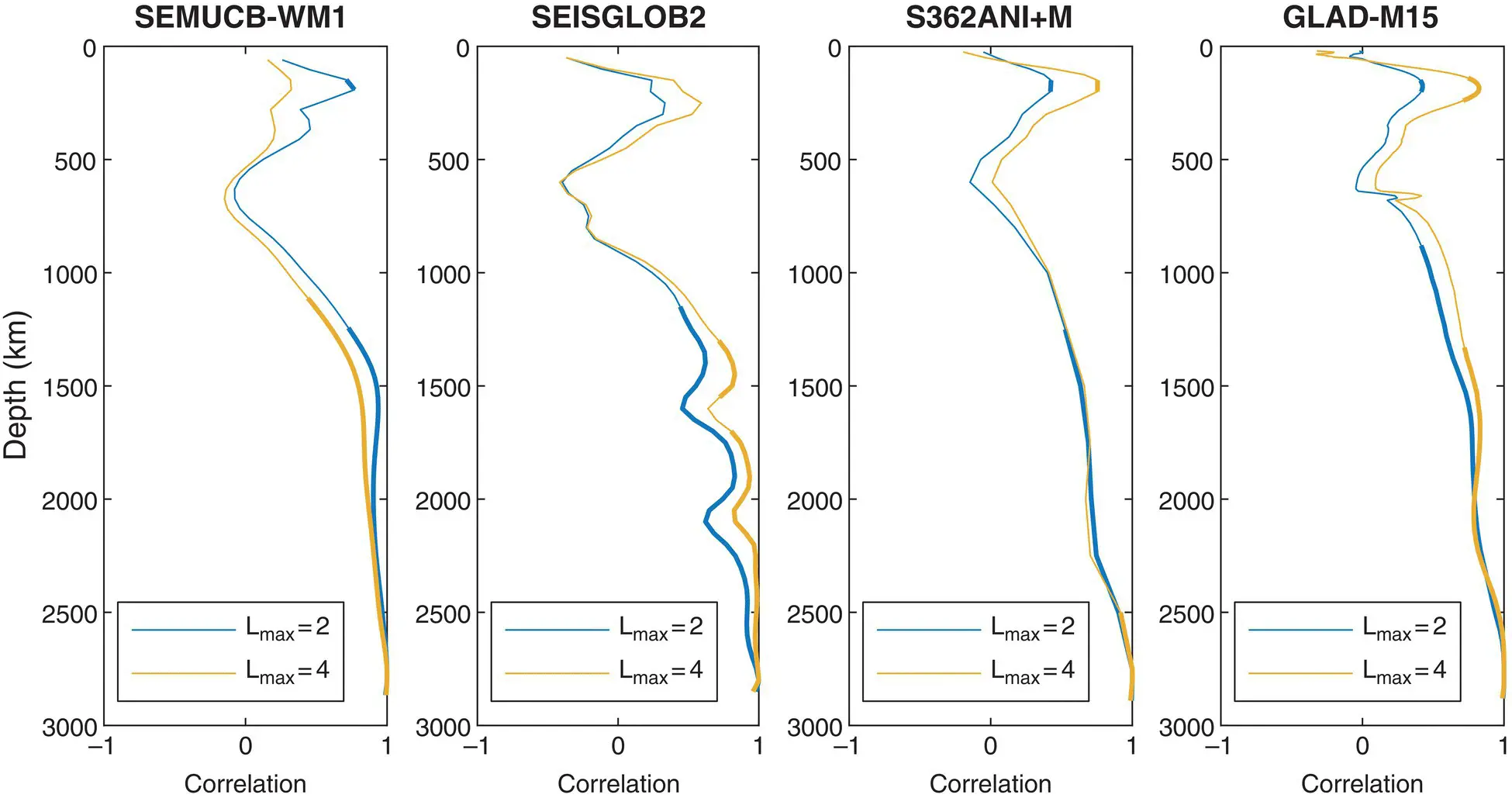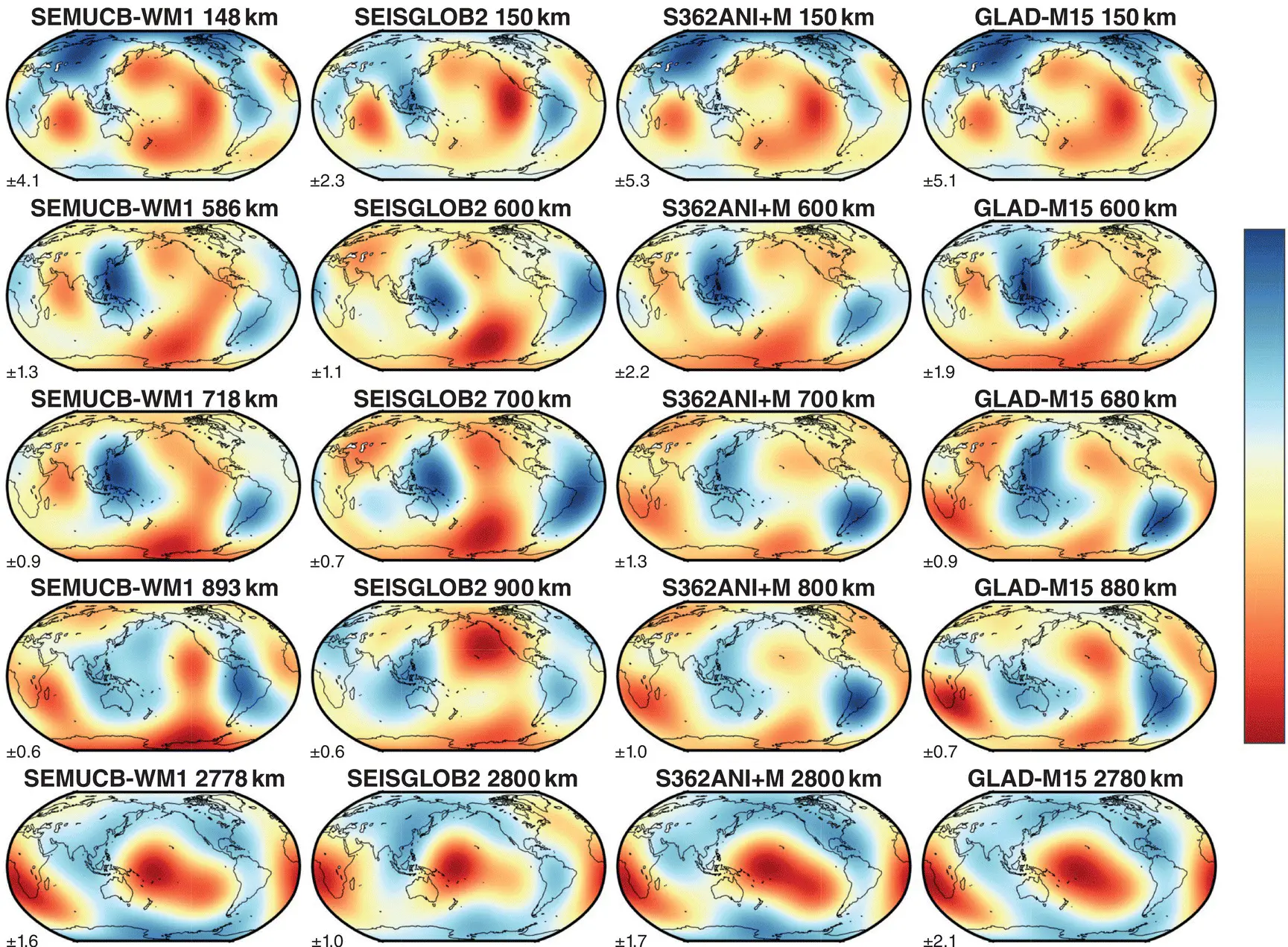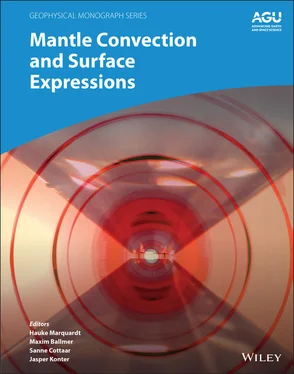Part I State of the Mantle: Properties and Dynamic Evolution
1 Long‐Wavelength Mantle Structure: Geophysical Constraints and Dynamical Models
Maxwell L. Rudolph 1, Diogo L. Lourenço 1, Pritwiraj Moulik 2, and Vedran Lekić 2
1 Department of Earth and Planetary Sciences, University of California, Davis, CA, USA
2 Department of Geology, University of Maryland, College Park, MD, USA
The viscosity of the mantle affects every aspect of the thermal and compositional evolution of Earth’s interior. Radial variations in viscosity can affect the sinking of slabs, the morphology of plumes, and the rate of convective heat transport and thermal evolution. Below the mantle transition zone, we detect changes in the long‐wavelength pattern of lateral heterogeneity in global tomographic models, a peak in the the depth‐distribution of seismic scatterers, and changes in the dynamics plumes and slabs, which may be associated with a change in viscosity. We analyze the long‐wavelength structures, radial correlation functions, and spectra of four recent global tomographic models and a suite of geodynamic models. We find that the depth‐variations of the spectral slope in tomographic models are most consistent with a geodynamic model that contains both a dynamically significant phase transition and a reduced‐viscosity region at the top of the lower mantle. We present new inferences of the mantle radial viscosity profile that are consistent with the presence of such a feature.
Heterogeneity in Earth’s mantle is dominated by its very long‐wavelength components in the upper mantle, transition zone, and the lowermost mantle. Such long‐wavelength variations reflect the distribution of the continents and the ocean basins in the uppermost mantle, subducted slabs in the transition zone and the degree‐2 dominant continent‐sized large low shear velocity provinces (LLSVPs) in the lowermost mantle. The long‐wavelength structure of the upper mantle is positively correlated with the lowermost mantle structure ( Figure 1.1), supporting the well‐established idea that the lower mantle and lithospheric plate systems mutually interact through subduction and upwelling to produce related large‐scale structures. However, the transition zone and shallow lower mantle contain large‐scale heterogeneity that is weakly anticorrelated with the upper mantle and lowermost mantle. Observations of deflected upwellings, slab stagnation above and below the 650 km phase transition, the presence of seismic scatterers, and changes in the large‐scale pattern of mantle structure suggest the possibility of changes in mantle properties across this region that lack a single agreed‐upon explanation.
The presence of faster‐than‐average material surrounding the pair of LLSVPs in the lowermost mantle can be explained well by models of slab sinking constrained by subduction history, assuming that slabs sink vertically from the trench (Ricard et al., 1993), even when using only the most recent 200 Myr of subduction history. Although the thermochemical nature of LLSVPs is sometimes debated (e.g., Davies et al., 2015), several lines of evidence now suggest that the LLSVPs are both warmer and compositionally distinct from the surrounding lower mantle. The anti‐correlation of shear‐ and bulk sound speed (Su and Dziewonski, 1997; Masters et al., 2000), sharp boundaries imaged by detailed waveform modeling (e.g., He and Wen, 2009; Wang and Wen, 2007), tidal constraints (Lau et al., 2017), and inferences of density from full‐spectrum tomography (e.g., Moulik and Ekström, 2016) are all consistent with a thermochemical rather than purely thermal origin of the LLSVPs. Additional evidence for a thermochemical origin is provided by the distribution of present day hotspots near the interiors and margins of the LLSVPs (Thorne et al., 2004; Burke et al., 2008; Austermann et al., 2014), expected on the basis of laboratory analogue experiments and numerical simulations (Davaille et al., 2002; Jellinek and Manga, 2002), as well as the observation that primitive helium isotope ratios in ocean island basalts are associated with mantle plumes rooted in the LLSVPs (e.g., Williams et al., 2019). The reconstructed eruption locations of large igneous provinces also fall near the present‐day boundaries of the LLSVPs (Burke and Torsvik, 2004; Torsvik et al., 2006), which supports the idea that the LLSVPs have been relatively stable over at least the past 200 Myr. Geodynamic models that impose time‐dependent, paleogeographically constrained plate motions can produce chemical piles whose large‐scale features are consistent with the morphology of the LLSVPs (e.g., McNamara and Zhong, 2005; Bower et al., 2013; Rudolph and Zhong, 2014).

Figure 1.1 Correlation between structure at 2800 km depth and other mantle depths for each of four tomographic models. Correlations for spherical harmonic degrees 1–2 are shown in blue and degrees 1–4 are shown in yellow. Where the curves are thicker, the correlation is significant at the p = 0.05 level.
All recent global tomographic models are generally in very good agreement at long wavelengths in the lowermost mantle (e.g., Becker and Boschi, 2002; Cottaar and Lekic, 2016). The long‐wavelength structure, comprising spherical harmonic degrees 1–4, is consistent in the upper and lowermost mantle across four recent global V Stomographic models ( Figure 1.2). However, shear velocity variations across the mantle transition zone and shallow lower mantle appear to shift to a pattern that is weakly anticorrelated with structure in both the asthenosphere and lowermost mantle. This change in large‐scale structure, evident in the global maps of V Svariations ( Figure 1.2), is also captured by the mantle radial correlation function (RCF), shown in Figure 1.3(e.g., Jordan et al., 1993; Puster and Jordan, 1994), which measures the similarity of the pattern of structures between every pair of depths in the mantle. Radial correlation analyses of global tomographic models reveal a zone of decorrelation across the transition zone and shallow lower mantle. Some (but not all) recent global shear‐wave (e.g., French and Romanowicz, 2014; Durand et al., 2017) and P wave (Fukao and Obayashi, 2013; Obayashi et al., 2013) tomographic models show a dramatic change in the radial correlation structure near 1,000 km depth. While the precise depth of the change in the long‐wavelength correlation is affected by the data constraints and model parameterization choices of the tomographic models (discussed later), it appears to coincide with other shorter‐wavelength features such as scatterers and deflected plumes, suggesting that they may share a common dynamical origin.

Figure 1.2 Shown here are plots of Voigt V Svariations at spherical harmonic degrees 1–4 from four recent tomographic models at selected depths across the transition zone and shallow lower mantle and within the lowermost mantle and the lithosphere. In each subpanel, the amplitude of the color scale is indicated in percent.

Figure 1.3 Radial correlation functions computed for four recent global tomographic models. The color scale indicates the value of the correlation between structures at different mantle depths. In each panel, the lower‐left triangle is the RCF for only spherical harmonic degrees 1–2, while the upper right triangle shows the RCF for degrees 1–4.
Читать дальше















